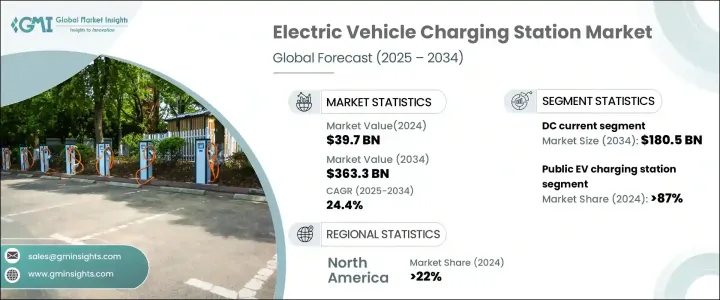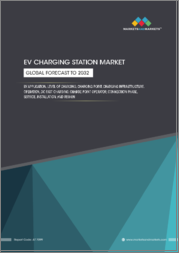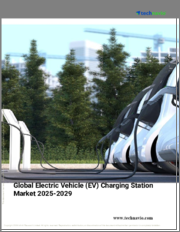
|
시장보고서
상품코드
1698569
세계의 전기자동차 충전소 시장 - 기회, 성장 촉진요인, 산업 동향 분석, 예측(2025-2034년)Electric Vehicle Charging Station Market Opportunity, Growth Drivers, Industry Trend Analysis, and Forecast 2025-2034 |
||||||
세계의 전기자동차 충전소 시장은 2024년 397억 달러로, 2025년부터 2034년까지 연평균 복합 성장률(CAGR) 24.4%로 성장할 것으로 예측됩니다.
전기자동차의 급속한 보급, 정부의 지원 정책, 충전 기술의 진보가 이러한 성장의 주요 촉진요인입니다. 급속 충전 인프라에 대한 수요가 증가함에 따라 자동차 제조업체와 에너지 공급업체는 대규모 충전 네트워크에 대한 협력을 추진하고 있습니다.

세계 각국의 정부는 보급을 가속화하기 위해 인센티브와 보조금을 확대하고 있습니다. 그리고 지역에 따라 충전 규격과 프로토콜이 다르기 때문에 상호 운용성은 여전히 큰 과제가 되고 있습니다.
| 시장 범위 | |
|---|---|
| 시작 연도 | 2024년 |
| 예측 연도 | 2025-2034년 |
| 시작 금액 | 397억 달러 |
| 예측 금액 | 3,633억 달러 |
| CAGR | 24.4% |
전기자동차 충전소 시장은 2022년에 257억 달러, 2023년에는 307억 달러, 2024년에는 397억 달러에 달했습니다. DC 급속 충전으로의 전환은 특히 상용 및 고속도로 용도에서 가속하고 있습니다. 이 충전기는 충전 시간을 대폭 단축하기 때문에 장거리 이동이나 상용차에 최적입니다. 그러나, 고가의 기기, 고급 그리드 통합, 인프라 요건 때문에 DC 급속 충전기의 도입에 걸리는 고비용은 여전히 장벽이 되고 있습니다.
AC 충전은 속도가 느리지만 합리적인 가격으로 널리 사용할 수 있기 때문에 주택이나 직장에서의 사용에는 여전히 중요합니다. 레벨 1 및 레벨 2 AC 충전기는 가정, 사무실 및 공공 장소에서 널리 사용됩니다. 공공 AC 충전소은 7.4kW의 최소 출력 요구 사항을 충족해야합니다.
공공 충전소는 2024년 시장 점유율의 87% 이상을 차지하며, 2034년까지 매년 26% 이상의 성장이 전망되고 있습니다. 충전소 설치는 최근 급증하고 있으며, 항속 거리에 대한 불안을 완화하고 장거리 이동을 용이하게 하고 있습니다. 공공 충전 인프라에 대한 자금 조달의 상황은 진화하고 있어 정부와 민간 단체 모두로부터 다액의 투자가 행해지고 있습니다.
이러한 진전에도 불구하고 높은 설치 비용, 토지 취득 비용, 송전망 용량의 제한 등의 과제도 남아 있습니다. 자동 과금, 스마트 그리드 통합, 상호 운용성 요구 사항 등 현재 진행 중인 기술적 진보는 EV 충전 네트워크의 효율을 높일 것으로 보입니다.
북미는 2024년에 시장 수익의 22% 이상을 차지하며, 그 점유율은 2034년까지 더욱 확대될 것으로 예상됩니다. 미국 전기자동차 충전소 시장은 2022년 4억 달러에서 2023년 5억 달러, 2024년에는 7억 달러로 성장했습니다. National Electric Vehicle Infrastructure Formula Program은 모든 주에 걸친 상호 연결 충전 네트워크 개발에 50억 달러를 할당하고 있습니다.
목차
제1장 조사 방법과 조사 범위
- 시장 범위와 정의
- 시장 추계 및 예측 파라미터
- 예측 계산
- 데이터 소스
제2장 주요 요약
제3장 업계 인사이트
- 생태계 분석
- 규제 상황
- 업계에 미치는 영향요인
- 성장 촉진요인
- 업계의 잠재적 위험 및 과제
- 성장 가능성 분석
- Porter's Five Forces 분석
- PESTEL 분석
제4장 경쟁 구도
- 소개
- 전략적 전망
- 혁신과 지속가능성의 전망
제5장 시장 규모와 예측 : 전류별, 2021-2034년
- 주요 동향
- AC
- 레벨 1
- 레벨 2
- DC
- DC 퍼스트
- 기타
제6장 시장 규모와 예측 : 충전소별, 2021-2034년
- 주요 동향
- 공공
- 민간
제7장 시장 규모와 예측 : 지역별, 2021-2034년
- 주요 동향
- 북미
- 미국
- 캐나다
- 멕시코
- 유럽
- 노르웨이
- 독일
- 프랑스
- 네덜란드
- 영국
- 스웨덴
- 아시아태평양
- 중국
- 일본
- 인도
- 한국
- 싱가포르
- 중동 및 아프리카
- 사우디아라비아
- 아랍에미리트(UAE)
- 남아프리카
- 라틴아메리카
- 브라질
- 아르헨티나
제8장 기업 프로파일
- ABB
- Blink Charging
- CHAEVI
- ChargePoint
- Delta Electronics
- Eaton
- Elli
- EVBox
- GreenWay Infrastructure
- Hyundai Motor
- Leviton Manufacturing
- NIO
- Nissan Motor
- Schneider Electric
- Siemens
- SK Signet
- Tesla
- VinFast
- Volta
- Zunder
The Global Electric Vehicle Charging Station Market reached USD 39.7 billion in 2024 and is projected to grow at a CAGR of 24.4% from 2025 to 2034. The rapid adoption of electric vehicles, supportive government policies, and advancements in charging technologies are key drivers of this growth. Increasing demand for fast-charging infrastructure is prompting automakers and energy providers to collaborate on large-scale charging networks.

Governments worldwide are expanding incentives and subsidies to accelerate deployment. Regulatory initiatives are shaping the industry by mandating widespread charging infrastructure. The integration of IoT and artificial intelligence optimizes load management and enhances grid integration. However, interoperability remains a significant challenge due to diverse charging standards and protocols across different regions. The industry is also shifting toward renewable energy integration, with many charging stations incorporating solar power and battery storage to improve sustainability.
| Market Scope | |
|---|---|
| Start Year | 2024 |
| Forecast Year | 2025-2034 |
| Start Value | $39.7 Billion |
| Forecast Value | $363.3 Billion |
| CAGR | 24.4% |
The market for electric vehicle charging stations stood at USD 25.7 billion in 2022 and USD 30.7 billion in 2023 before reaching USD 39.7 billion in 2024. The segment includes AC and DC charging, with DC charging dominating the market and expected to surpass USD 180.5 billion by 2034. The transition toward DC fast charging is accelerating, particularly in commercial and highway applications. These chargers significantly reduce charging time, making them ideal for long-distance travel and commercial fleets. However, the high cost of deploying DC fast chargers remains a barrier due to expensive equipment, advanced grid integration, and infrastructure requirements. The estimated investment for a single DC fast charging station ranges between USD 62,160 and USD 248,640.
AC charging, while slower, remains crucial for residential and workplace use due to affordability and widespread availability. Approximately 80% of electric vehicle charging occurs at home, making AC chargers essential for daily commuting. Level 1 and Level 2 AC chargers are widely used in households, offices, and public areas. Public AC charging stations must meet a minimum output power requirement of 7.4 kW.
Public charging stations accounted for over 87% of the market share in 2024 and are expected to grow at more than 26% annually until 2034. Expansion efforts are particularly focused on urban areas, highways, and commercial centers to support the increasing EV fleet. Charging point installations have surged in recent years, alleviating range anxiety and facilitating long-distance travel. The funding landscape for public charging infrastructure is evolving, with significant investments from both governments and private entities. The U.S. government has committed USD 5 billion to expand EV charging infrastructure through 2026.
Despite these advancements, challenges persist, including high installation costs, land acquisition expenses, and grid capacity limitations. Installation costs for fast-charging stations vary between USD 20,836 and USD 104,180. Residential and workplace charging remains the preferred choice due to cost-effectiveness, with home charging being up to 50% cheaper than public stations. Ongoing technological advancements, including automated billing, smart grid integration, and interoperability requirements, will enhance the efficiency of EV charging networks. By 2025, all public charging stations will be required to comply with interoperability regulations, ensuring seamless access for EV users.
North America held over 22% of the market revenue in 2024, with its share expected to increase further by 2034. The U.S. EV charging station market grew from USD 400 million in 2022 to USD 500 million in 2023 and USD 700 million in 2024. Federal and state-level funding initiatives are fueling this growth. The National Electric Vehicle Infrastructure Formula Program allocates USD 5 billion to develop an interconnected charging network across all states. The U.S. government has committed USD 7.5 billion to building a nationwide EV charging infrastructure of 500,000 chargers, ensuring a robust and accessible network for electric vehicle users.
Table of Contents
Chapter 1 Methodology & Scope
- 1.1 Market scope & definitions
- 1.2 Market estimates & forecast parameters
- 1.3 Forecast calculation
- 1.4 Data sources
- 1.4.1 Primary
- 1.4.2 Secondary
- 1.4.2.1 Paid
- 1.4.2.2 Public
Chapter 2 Executive Summary
- 2.1 Industry synopsis, 2021 - 2034
Chapter 3 Industry Insights
- 3.1 Industry ecosystem analysis
- 3.2 Regulatory landscape
- 3.3 Industry impact forces
- 3.3.1 Growth drivers
- 3.3.2 Industry pitfalls & challenges
- 3.4 Growth potential analysis
- 3.5 Porter's analysis
- 3.5.1 Bargaining power of suppliers
- 3.5.2 Bargaining power of buyers
- 3.5.3 Threat of new entrants
- 3.5.4 Threat of substitutes
- 3.6 PESTEL analysis
Chapter 4 Competitive Landscape, 2024
- 4.1 Introduction
- 4.2 Strategic outlook
- 4.3 Innovation & sustainability landscape
Chapter 5 Market Size and Forecast, By Current, 2021 – 2034 (Units, USD Billion)
- 5.1 Key trends
- 5.2 AC
- 5.2.1 Level 1
- 5.2.2 Level 2
- 5.3 DC
- 5.3.1 DC Fast
- 5.3.2 Others
Chapter 6 Market Size and Forecast, By Charging Site, 2021 – 2034 (Units, USD Billion)
- 6.1 Key trends
- 6.2 Public
- 6.3 Private
Chapter 7 Market Size and Forecast, By Region, 2021 – 2034 (Units, USD Billion)
- 7.1 Key trends
- 7.2 North America
- 7.2.1 U.S.
- 7.2.2 Canada
- 7.2.3 Mexico
- 7.3 Europe
- 7.3.1 Norway
- 7.3.2 Germany
- 7.3.3 France
- 7.3.4 Netherlands
- 7.3.5 UK
- 7.3.6 Sweden
- 7.4 Asia Pacific
- 7.4.1 China
- 7.4.2 Japan
- 7.4.3 India
- 7.4.4 South Korea
- 7.4.5 Singapore
- 7.5 Middle East & Africa
- 7.5.1 Saudi Arabia
- 7.5.2 UAE
- 7.5.3 South Africa
- 7.6 Latin America
- 7.6.1 Brazil
- 7.6.2 Argentina
Chapter 8 Company Profiles
- 8.1 ABB
- 8.2 Blink Charging
- 8.3 CHAEVI
- 8.4 ChargePoint
- 8.5 Delta Electronics
- 8.6 Eaton
- 8.7 Elli
- 8.8 EVBox
- 8.9 GreenWay Infrastructure
- 8.10 Hyundai Motor
- 8.11 Leviton Manufacturing
- 8.12 NIO
- 8.13 Nissan Motor
- 8.14 Schneider Electric
- 8.15 Siemens
- 8.16 SK Signet
- 8.17 Tesla
- 8.18 VinFast
- 8.19 Volta
- 8.20 Zunder



















